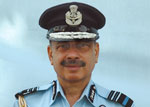INDIAN ARMED FORCES CHIEFS ON OUR RELENTLESS AND FOCUSED PUBLISHING EFFORTS

The insightful articles, inspiring narrations and analytical perspectives presented by the Editorial Team, establish an alluring connect with the reader. My compliments and best wishes to SP Guide Publications.

"Over the past 60 years, the growth of SP Guide Publications has mirrored the rising stature of Indian Navy. Its well-researched and informative magazines on Defence and Aerospace sector have served to shape an educated opinion of our military personnel, policy makers and the public alike. I wish SP's Publication team continued success, fair winds and following seas in all future endeavour!"

Since, its inception in 1964, SP Guide Publications has consistently demonstrated commitment to high-quality journalism in the aerospace and defence sectors, earning a well-deserved reputation as Asia's largest media house in this domain. I wish SP Guide Publications continued success in its pursuit of excellence.
- The layered Air Defence systems that worked superbly, the key element of Operation Sindoor
- Operation Sindoor | Day 2 DGMOs Briefing
- Operation Sindoor: Resolute yet Restrained
- India's Operation Sindoor Sends a Clear Message to Terror and the World – ‘ZERO TOLERANCE’
- Japan and India set forth a defence cooperation consultancy framework, talks on tank and jet engines
Practice Forced Landing

Possibly my earlier experience of carrying out an engine-off pattern in the Kiran gave me the confidence of gliding the L-39 back to the airfield. I made it to the runway, literally, by the skin of my teeth.
I attended the 43rd Qualified Flying Instructors’ Course in June 1973. It was the first time that flying training was to be carried out on the newly acquired Kiran jet trainer along with the good old HT-2. The intention was to train a few instructors, who would then be able to teach the budding pilots at the Air Force Academy (AFA), Dundigal. As the junior most trainees’ Qualified Flying Instructor (QFI), I was flying with my instructor, then Squadron Leader Pingale, we also had the unique experience of unintentionally entering and recovering from an inverted spin. Due to this unusual coincidence, the Chief Test Pilot at Hindustan Aeronautics Limited, Bengaluru, had interviewed both of us.
On completion of the course, six of us QFIs were posted to the Kiran Flight at AFA. Along with six other senior instructors, who had also converted to Kiran, we were to train 20 flight cadets of 113 F (P) course directly on the Kiran trainer, after their basic training on the HT-2. We taught Practice Forced Landing (PFL) to the flight cadets. The simulation was carried out by setting the throttle to idle, air-brakes out and flaps to take-off position. With this configuration we used to get a Rate of Descent of approximately 1,200-1,500 ft/min. The classical pattern had designated heights of 5,500 ft for High Key, 4,000 ft for the Mid Key and 2,500 ft at Low Key, which is abeam the landing dumbbell on downwind. Kiran is a dependable trainer fitted with a Rolls-Royce engine. One morning, I along with a senior instructor was carrying out Continuity Training. Having completed the assigned manoeuvres, we had enough fuel left over, to carry out one PFL and a couple of circuits and landings. As we were about to initiate the PFL, a thought occurred as to why not switch off the engine and ascertain whether the simulated configuration matches with actual conditions.
We sought permission from the Air Traffic Control to carry out a PFL and were asked to report at High Key. Then, without giving too much of thought to propriety, we actually switched the engine off, plunging the cockpit in silence. Seated side-by-side, we looked at each other, as if reassuring ourselves of a safe recovery. The aircraft flew well. We had naturally not selected the air-brakes out or the flaps to takeoff, but the aircraft wasn’t losing as much height as we were used to in a PFL. We had to, therefore, zigzag a bit to reach both the Mid Key and Low Key points. On the approach, we lowered the flaps early to get the correct perspective. On the short finals we had decided to relight the engine, which it did on the very first attempt. We then carried out an overshoot, for a full stop, thereafter.
Having realised that the configuration selected during PFL were not replicating the actual conditions of an engineoff landing, we were now wondering as to how to put this across to the seniors; after all we had not been authorised to do so. Normally, such issues are in the realm of test flying and are so tasked. However, knowing the seriousness in case of an actual incident, we decided to tell the truth. To our surprise, the Chief Flying Instructor was very receptive and after a reprimand, he asked us to write out a proper report and additional briefing points.





